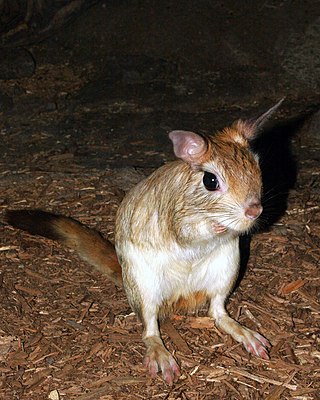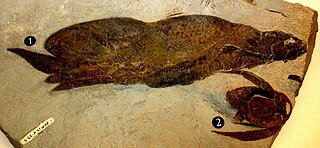
Calcium chloride is an inorganic compound, a salt with the chemical formula CaCl2. It is a white crystalline solid at room temperature, and it is highly soluble in water. It can be created by neutralising hydrochloric acid with calcium hydroxide.
Alliance University was a private Christian university affiliated with the Christian and Missionary Alliance. Located in New York, New York, the university offered undergraduate and graduate programs; in addition, it included Alliance Theological Seminary.

Zapodidae, the jumping mice, is a family of mouse-like rodents in North America and China.

Anomaluromorpha is a clade that unites the anomalures, springhares, and zenkerella. It has alternately been designated as either a suborder or infraorder. Most recently, Carleton & Musser 2005 recognized it as one of five suborders of rodents.

Latimeriidae is the only extant family of coelacanths, an ancient lineage of lobe-finned fish. It contains two extant species in the genus Latimeria, found in deep waters off the coasts of southern Africa and east-central Indonesia. In addition, several fossil genera are known from the Mesozoic of Europe, the Middle East, and the southeastern United States, dating back to the Triassic.

Epihippus is an extinct genus of the modern horse family Equidae that lived in the Eocene, from 46 to 38 million years ago.
Semecarpus kraemeri, or Chuuk poisontree, is a species of plant in the family Anacardiaceae. It is endemic to the island of Chuuk within the Federated States of Micronesia. A fellow endemic, the great Truk white-eye is thought to depend on this plant for survival.

Eotomariidae is an extinct family of gastropods in the clade Vetigastropoda.
Ganorhynchus is an extinct genus of prehistoric lungfish from the Devonian period. It is only found in Mansfield, Pennsylvania.

Scaumenacia is an extinct genus of prehistoric lungfish. It lived around the Devonian in North America alongside another prehistoric lungfish: Fleurantia. It lived from approximately 384 to 376 millions of years ago.

Chelonoidis is a genus of turtles in the tortoise family erected by Leopold Fitzinger in 1835. They are found in South America and the Galápagos Islands, and formerly had a wide distribution in the West Indies.

The Kupferschiefer or Kupfermergel, is an extensive and remarkable sedimentary unit in Central Europe. The relatively monotonous succession is typically 30 to 60 centimetres and maximum 2 metres (6.6 ft) thick, but extends over an area of 600,000 square kilometres (230,000 sq mi) across the Southern Permian Basin. The Kupferschiefer can be found in outcrop or in the subsurface straddling six countries, including parts of the southern North Sea. The lateral equivalent outcropping in England is called Marl Slate.

Boreostemma is an extinct genus of glyptodonts from northern South America. Fossils assigned to the genus were first described as belonging to Asterostemma from southern South America, but have been placed in the new genus Boreostemma by Carlini et al. in 2008. The type species is B. pliocena. Fossils of Boreostemma have been found in the Honda Group of Colombia, in Peru and Venezuela.
The borate fluorides or fluoroborates are compounds containing borate or complex borate ions along with fluoride ions that form salts with cations such as metals. They are in the broader category of mixed anion compounds. They are not to be confused with tetrafluoroborates (BF4) or the fluorooxoborates which have fluorine bonded to boron.
Annea is an extinct genus of carpet shark from the middle Jurassic epoch of the Jurassic period. It is currently known by two species. A. carinata is known from the upper Aalenian and lower Bajocian of Germany. A. maubeugei is known from the middle Toarcian of Belgium. Its name honors Dr. P. L. Maubeuge, who studied the Jurassic of Lorraine in which this species was found. This genus appears to exhibit heterodonty.
Phestia is an extinct genus of clam belonging to order Nuculanida and family Nuculanidae.
Paratropes fossilis is an extinct species of cockroach within the family Ectobiidae that lived during the Cretaceous period. The holotype is an isolated right tegmen 24 millimeters in length. The type locality is in the Gerofit Locality within the Ora Formation located in Israel.
Rhinoporidae is an extinct family of bryozoans within the order Cystoporida. There are currently 3 genera assigned to the family. Members of this family have lived from the Ordovician to the Devonian.

Fistuliporidae is an extinct family of bryozoans within the order Cystoporida. Members of this family have lived from the early Ordovician to the late Triassic period.

Echinodiscus is a genus of sand dollars within the family Astriclypeidae. There are currently 14 species assigned to the genus, with a majority being extinct.











